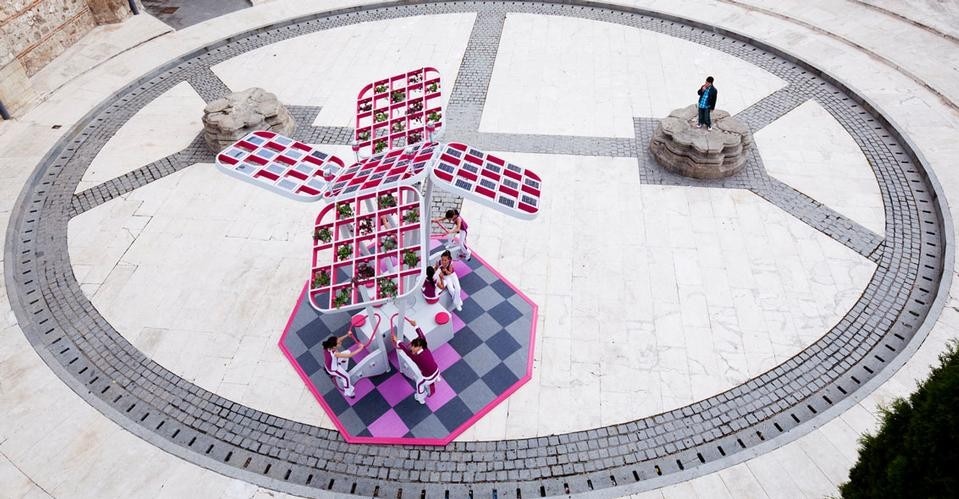As anticipated (see: Forms of Energy #2), this global event dedicated an unusual amount of space to architecture in two sessions – one entitled "PV Elegance and Performance," and the other, more general, "PV Systems."
We will focus on three projects that illustrate the different meanings that photovoltaic technology can take on in the design process.
The Spanish office, ELII Arquitectos (Uriel Fogué, Eva Gil Lopesino, Carlos Palacios with Elena Cuerda, Enrico Forestieri, Ana López) presented the project for the General Vara del Rey square in Madrid (published in Forms of Energy #1).
The design of the public space is played out in the inclusion of photovoltaic "trees" that perform different functions. Invading space as a new kind of citizen which, by replacing the natural tree species (because they are in the city) and winning the right to occupy urban space, they also perform the job of contributing to the life of that space generating energy and communicating to other species, the human one, how they produce it and how much they produce (interactivity).
Marco Acerbis, asked to describe the design of new photovoltaic components, presented the project developed for Xeliox Energy Lab, a manifesto- building for a company that produces solar parabolic troughs. Here the formally distinctive element is a large photovoltaic surface forming the diaphragm that screens a southern façade whose rhythm is defined by the repetition of a photovoltaic component sloping to find the sun.
The project's goal is, in fact, to correct an imperfect orientation because the façade is not perfectly south-facing. The idea is that if you can't rotate the building, whose position had already been defined, then you can rotate the façade's single elements appropriately in order to face the sun correctly. And thus the façade element –reminiscent of the beveled rustication of Renaissance palaces – was generated.
It might be said that Acerbis approaches photovoltaics as a designer, imagining a component that is formally innovative and that can be easily industrialized thanks to a simple technological solution based on the use of ordinary photovoltaic modules and the development of a connection system that "mediates" formal requirements and industrial logic. The point of arrival, returning to the theme of the conference session that hosted his speech, is a fine balance between elegance (form) and performance (function) implemented through design.
During the closing session, Simone Giostra, invited as a U.S. representative to discuss the issue of the use of photovoltaic technology in the innovative design of facades, presented a journey through the theme of the façade, including new technologies and "hybrid" possibilities. Based on a rigorous architectural and rational approach, he told the story of the evolution of the facade from the first curtain walls to contemporary solar facades designed by SG & P (of these, perhaps, Green Pix in Beijing is the best known). In the examples illustrated, we might be able to say that the facade is never just a facade, for example functioning as screen or sunshade, just as we might affirm that photovoltaics produce energy but also create a pattern of pixels or louvers, or that the individual technological components (modules or louvers) are also hybrids derived from the fusion of different technologies such as photovoltaics and LEDs designed to perform various functions such as lighting and communicating, or even conflicting ones, such as screening and lighting.
In this journey-story, step by step, the use of photovoltaics becomes increasingly sophisticated (again, not technically as much as conceptually), revealing a complex vision of architecture and building surfaces, in relation to which, time and again, technology finds a different formal expression functional to the (complex) performance of the building in which it plays an active role...
One might ask why so much space was given over to architecture in a scientific conference. The answer is a long one but suffice it to say that after a period in which architects were engaged in understanding how to operate photovoltaics, finally, now, they can tell how they have used them and present convincing theories and examples.
And the photovoltaic public is curious, and, hopefully, ready to transcend the limits which are traditionally quite rigid.
In Valencia, at least for a few days, these limits were truly tested to the point that the award for the best visual presentation in the "PV Systems" category – which included anything and everything that has to do with a photovoltaic system – went to a project by a young designer, Dimitrios Tselepis, who designed a photovoltaic tent, Heliodome. Far from the sophisticated devices created to pursue efficiency, the tent can be carried in a backpack so that the technology's most loyal can take it along wherever they want, find shelter and perhaps think about new technological developments. Alessandra Scognamiglio
Forms of Energy #3
Hybridding architecture and photovoltaics. We return to the 25th European Photovoltaic Solar Energy Conference, held in early September in Valencia, to report on what the architects said.

View Article details
- Alessandra Scognamiglio
- 18 October 2010
- Valencia